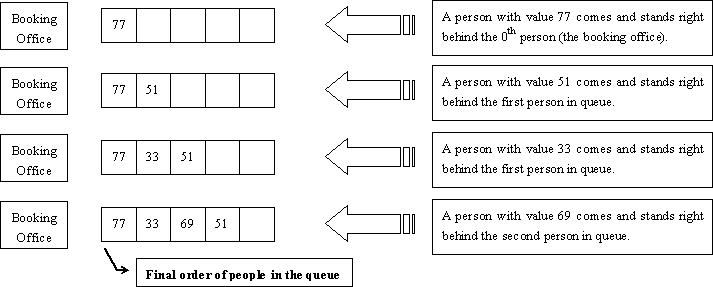Buy Tickets poj 2828
来源:互联网 发布:linq join 重复数据 编辑:程序博客网 时间:2024/05/28 16:00
Description
Railway tickets were difficult to buy around the Lunar New Year in China, so we must get up early and join a long queue…
The Lunar New Year was approaching, but unluckily the Little Cat still had schedules going here and there. Now, he had to travel by train to Mianyang, Sichuan Province for the winter camp selection of the national team of Olympiad in Informatics.
It was one o’clock a.m. and dark outside. Chill wind from the northwest did not scare off the people in the queue. The cold night gave the Little Cat a shiver. Why not find a problem to think about? That was none the less better than freezing to death!
People kept jumping the queue. Since it was too dark around, such moves would not be discovered even by the people adjacent to the queue-jumpers. “If every person in the queue is assigned an integral value and all the information about those who have jumped the queue and where they stand after queue-jumping is given, can I find out the final order of people in the queue?” Thought the Little Cat.
Input
There will be several test cases in the input. Each test case consists of N + 1 lines where N (1 ≤ N ≤ 200,000) is given in the first line of the test case. The next N lines contain the pairs of values Posi and Vali in the increasing order of i (1 ≤ i ≤ N). For each i, the ranges and meanings of Posi and Vali are as follows:
- Posi ∈ [0, i − 1] — The i-th person came to the queue and stood right behind the Posi-th person in the queue. The booking office was considered the 0th person and the person at the front of the queue was considered the first person in the queue.
- Vali ∈ [0, 32767] — The i-th person was assigned the value Vali.
There no blank lines between test cases. Proceed to the end of input.
Output
For each test cases, output a single line of space-separated integers which are the values of people in the order they stand in the queue.
Sample Input
40 771 511 332 6940 205231 192431 38900 31492
Sample Output
77 33 69 5131492 20523 3890 19243
Hint
The figure below shows how the Little Cat found out the final order of people in the queue described in the first test case of the sample input.

Source
题意:N个人去排队,给出第i个人插到第pos_i个人后面,求最后的顺序。
思路:线段树,插入更新的时候倒着插。
代码:
#include <iostream>#include <cstdio>#include <cstring>#include <algorithm>#include <cmath>#include <string>#include <map>#include <stack>#include <vector>#include <set>#include <queue>#define maxn 1005#define MAXN 200050#define lson rt<<1,l,mid#define rson rt<<1|1,mid+1,rtypedef long long ll;using namespace std;struct Node{ int l,r,num;};Node node[MAXN<<2];int ans[MAXN],po[MAXN],va[MAXN];void build(int rt,int l,int r){ node[rt].l=l; node[rt].r=r; node[rt].num=r-l+1; if (l==r) return ; int mid=(l+r)>>1; build(lson); build(rson);}void query(int rt,int pos,int val){ node[rt].num--; if (node[rt].l==node[rt].r) { ans[node[rt].l]=val; return; } if (node[rt<<1].num>=pos) query(rt<<1,pos,val); else query(rt<<1|1,pos-node[rt<<1].num,val);}int main(){ int i,j,n; while (scanf("%d",&n)!=EOF) { memset(ans,0,sizeof(ans)); build(1,1,n); for (i=1;i<=n;i++) scanf("%d%d",&po[i],&va[i]); for (i=n;i>0;i--) //倒着一个一个的插入 query(1,po[i]+1,va[i]); for (i=1;i<n;i++) printf("%d ",ans[i]); printf("%d\n",ans[n]); } return 0;}/*40 771 511 332 6940 205231 192431 38900 31492*/- poj 2828 Buy Tickets
- poj 2828 Buy Tickets
- poj 2828 Buy Tickets
- poj 2828 Buy Tickets
- POJ 2828 Buy Tickets
- Poj 2828 Buy Tickets
- poj 2828 buy tickets
- POJ 2828 Buy Tickets
- poj 2828 Buy Tickets
- poj 2828 Buy Tickets
- POJ 2828 - Buy Tickets
- POJ 2828 - Buy Tickets
- POJ-2828-Buy Tickets
- poj 2828 Buy Tickets
- poj 2828 Buy Tickets
- poj 2828 Buy Tickets
- POJ 2828 Buy Tickets
- POJ 2828 Buy Tickets
- 第十一周上机实践项目——存钱
- 第四章 思维导图
- 第十周上机项目6 贪财的富翁
- 加快了世界的疯了快解放路口附近了款式大方
- 十一月学习计划
- Buy Tickets poj 2828
- java集合详解
- C解压缩gzip数据
- redis基础之数据类型string
- 第十周项目六:贪财的富翁
- AppScan安全漏洞报告
- Html5 canvas 简单画布画板涂鸦例子
- WM_TIMER使用
- linux解压命令


